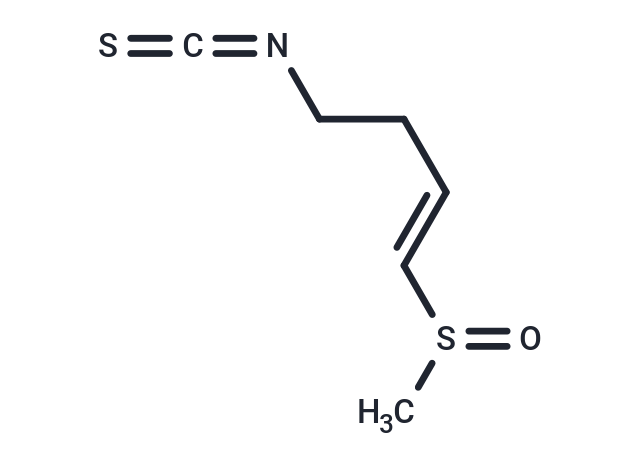Shopping Cart
- Remove All
 Your shopping cart is currently empty
Your shopping cart is currently empty


| Pack Size | Price | Availability | Quantity |
|---|---|---|---|
| 1 mg | $31 | In Stock | |
| 2 mg | $44 | In Stock | |
| 5 mg | $72 | In Stock | |
| 10 mg | $122 | In Stock | |
| 25 mg | $239 | In Stock | |
| 50 mg | $355 | In Stock | |
| 100 mg | $527 | In Stock | |
| 1 mL x 10 mM (in DMSO) | $63 | In Stock |
| Description | Sulforaphene is a natural product isolated from radish seeds, exhibits an ED50 against velvetleaf seedlings approximately 2 x 10 -4 M. Sulforaphene promotes cancer cells apoptosis and inhibits migration via inhibiting EGFR, p-ERK1/2, NF‐κB and other signa |
| In vitro | A herbicidal compound was isolated from extracts ofMatthiola incana and identified as Sulforaphene (4-methylsulfinyl-3-butenyl isothiocyanate). CONCLUSIONS: The ED50 of this compound against velvetleaf seedlings was approximately 2×10(-4) M. Glucoraphenin, the glucosinolate that is the natural precursor of Sulforaphene, was less phytotoxic, with an ED50 of near 6×10(-3)M. |
| Molecular Weight | 175.27 |
| Formula | C6H9NOS2 |
| Cas No. | 592-95-0 |
| Storage | store at low temperature | Powder: -20°C for 3 years | In solvent: -80°C for 1 year | Shipping with blue ice. | |||||||||||||||||||||||||||||||||||
| Solubility Information | DMSO: 100 mg/mL (570.55 mM), Sonication is recommended. | |||||||||||||||||||||||||||||||||||
Solution Preparation Table | ||||||||||||||||||||||||||||||||||||
DMSO
| ||||||||||||||||||||||||||||||||||||

Copyright © 2015-2024 TargetMol Chemicals Inc. All Rights Reserved.